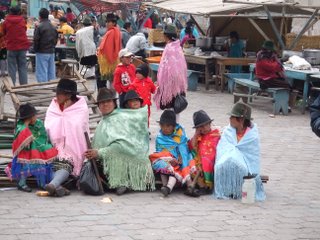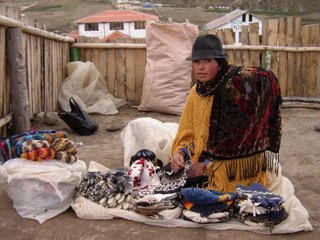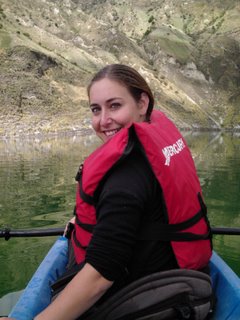

ECOTRACKERS REPORT WITH REGARD TO WOMENS GROUP PONCE-QUILOTOA
19 December 2006, Marieke Slootman
Stay in Quilotoa: 7-12 December
Containing:
- Evaluation of the stay
- My experiences with regard to the women´s group and the discussions held
- What the group needs
- Possible role for Ecotrackers
- Example form workshop
I - Evaluation of the stay
Evaluation of the stay: Buena-Regular
Plusses
What we valued:
- They expected us to come (family Jose and Maria + César), welcomed us when we arrived, and there was a decent room for us.
- César knew my mission and helped to arrange it.
- They took care of us:
- 3 meals a day on time
- César always asked what we wanted to do, and helped arranging it when we wanted
- the woman regularly offered hot water for bathing, warm clothes, to wash our clothes, etc.
- We did not get the feeling that we were regarded as a ´walking wallet´. César and the family did propose trips that would cost some money, and showed us their touristic products, but they were not imposing at all, and we could easily say ´no´. In the end we did a 3 hrs trip with horses for which we paid 10 USD p.p., but we did not feel pressured (that´s why we did it).
Minusses
What did not meet our expectations:
- They did not have a clear idea about JJ´s mission and we did not further develop that.
- We found it a pity that we did not eat with the family. The family ate in the kitchen, whereas we ate often a little earlier than we did (but we didn´t ask to join the meal either)
- In advance we requested to be with a family in Ponce, of whom the woman was an active member of the women´s group.
- In the end the discussion with the women´s group was not executed as César said he organised it (3 sessions), but there was only one session. What I found most dissappointing, is that César did not attend this meeting. I think that strongly affected the effectiveness of the discussion. (See my description below).
II - My experiences with regard to the women´s group and the discussions held
General
César, the contactperson of Quilotoa, and Max from Ecotrackers designed five discussions about five themes to be held in my presence with the new women´s group of Ponce, the neighbouring village of Quilotoa. I brought with me several papers written by Max, with questions for the discussion and which extensive introductions to the topics, in Spanish. These discussions aimed to shape the plans of the women´s group: in particular about their wishes with regard to their income generating activities, to possible help they want, to their relation with Ecotrackers, and about their knowledge and possible resources in their direct environment. On the Thursday we arrived, César explained to me that there would be 3 discussions, on the Friday, Saturday and Monday.
Also I brought an extensive questionnaire about many details about the Ponce community, which I handed to César on the first day, (with the discussion topics, after I read them). He was going to make sure the questionnaire was filled out.
Friday
On the Friday afternoon I went to Ponce with César and JJ, for the first discussion from 15.00-17.00. There, after waiting over one hour, finally three women gathered (not the director - but the vice-director was there) and a man, who was the husband of the director. With this man, César discussed the papers (in Quechua) during our waiting. In the end the man lead the gathering: he introduced the discussion briefly and introduced us, and I also introduced us briefly. César and the man told us that because of a meeting/gathering in Zumbahua most women were away and could not come to our discussion that day. That was why we could not have an discussion that afternoon. On Saturday this was also not possible, because of the market in Zumbahua, but a discussion was scheduled for Sunday from 10.00 to 15.00.
Sunday
On Sunday, in the morning César said he would come with me at 9.30. At 9.30 he said he would be at the discussion a bit late. In the end he did not show up untill the meeting had ended and the lunch was finished (at 15.00). He said he had had another important meeting in Quilotoa.
At 9.30 I walked with one of Césars brothers to Ponce, where indeed many women were gathering. At 12.15 we started the discussion, with over fifteen women and a few men. The director and the administrator, who would make the notes, were sitting in the front, as were I (a bit to the side). The director´s husband lead the entire meeting - I will call him ´chairman´. The women were more silent than the men. The women did bring up some points, but the men dominated the meeting. The vice-director had much to say though, and even though I could not understand what she said, because the whole discussion was in Cuechua (which was good, because it makes it easier to the women, because it´s their first language), this woman sounded strong, involved and very convincing to me. This was contrary to the (slightly younger?) director, who did not take part in the discussion at all, and was distracted by children and walked out several times.
It took them about an hour to cover all topics. There was not much of an discussion about most questions. For many questions the chairman themself proposed answers. Sometimes very short parts were explained to me in Spanish (which I found hard to understand, because of my still relatively poor Spanish and his slightly unclear voice). The administrator wrote down very little, which I found a pity because sometimes there seemed to be a short, but involved discussion. I asked several times if she could write down more, but she wouldn´t.
At 13.20 the discussion was finished. They had formulated answers to most of the questions and even started developing guidelines for their organisation – the next step they want to start with. I asked if I could get the report of the meeting and the questionnaire by the end of Monday, to take it with me on Tuesday when we would leave. That was okay. We went for lunch, prepared by the women and me (with especially for me some meat, very kind). Logically this was the one and only discussion. On my way back I ran into César, coming to our meeting...
At the end of the meeting I kind of urged them to start with developing very specific plans, otherwise they will never start with their activities and will never be able to ask for other funds. But this was a little too late to get much attention. I repeated this to the director in private, but she was shy and did not seem very interested to me. In the end of the stay I also mentioned this suggestion, and the other suggestion (see next part of the report) to César. On Tuesday César told me that the report and the questionnaire would not be ready untill Friday, and that he would take them to Ecotrackers.
Some remarks
- When I arrived the discussions seemed well organised at first.
- But in fact it appeared to be not so organised and in the end there was only one discussion.
- Unfortunately, there was no report when I left, and no finished questionnaire.
- What I regretted most, was that Cecar did not attend the discussion. I think it was important that he was there, because the discussions were his thing, and I have the impression that now they were not so effective. I think that his absence has three unwanted effects:
- There was not much of an discussion, and the meeting went way too quick: in 1 hour all topics were covered, and all questions answered.
- There was no good translation for me or way to talk about the meeting afterwards. I found it important that it was held in Quechua, but it was difficult for me now to briefly ask for an (understandable) explanation or to discuss parts of the meeting afterwards.
- No-one made extensive and careful notes of the meeting now.
III - What the group needs
(Of course the suggestions are based on my impressions during my short stay)
For this group to be a women´s group that develops its own income-generating activities and contributes to the development of the women specifically and of the community in general, two main steps are important.
A) MORE CENTRAL ROLE FOR THE WOMEN.
It is important that the women have a more central role in the group and in the activities and take the lead in discussing/thinking/organising
It is very well possible that the women in the group rely on the support of men, which might have different skills and can contribute to the development of the group, but taking the lead in their own organisation helps the women for example to develop new skills and gain self-confidence in new areas and create different role models.
Also when the group wants to request money from different sources as a women´s organisation, it is important that the organisation in reality is lead by women.
B) FURTHER CONCRETISATION OF THEIR PLANS
The groups is a registered group now, with (I think) paying members. They have a lot of income-generating plans, but there is a risk that they will not implemented in practice because the plans remain too general. The next step is to make the plans concrete, to start carrying them out and to try and get funding.
For this it is important that the plans are made very specific and detailed. This could be done in the following steps:
- For every member of the group: decide what income-generating activity she wants to engage in. They must choose from the selected options that get priority. In the meeting it was decided that the following activities get priority: production of specific vegetables - choose which vegetables -, production of handicrafts, performance of dance/theatre/music, organisation of tours. (Note: we have some doubts about developing touristic activities in Ponce, see other report of Jan-Joost).
- For every member of the group: determine what she needs and what the outcome will be (necesitas and resultadas); in products and in money. (Let every person fill in a form like my example-form).
- Of all these seperate forms: make one overall plan for the group, with in detail what is needed and what will be the results.
- Also: let the group (all the women!) think about their desired goals. It will probably be ´money´, but this is probably a means to do/achieve something else... What? Do they also want to improve their skills/position?
IV - Possible role for Ecotrackers
Ad A) A WOMAN OF THE GROUP AS CONTACT PERSON
To support the development of a more central role for women in the organisation, it is very important to have one of the women as a contactperson for the Ponce women´s group.
It is important that one of the women is the person whom Ecotrackers develops the ideas with, and who will lead the implementation of the ideas (like drafting the discussions like those that were held, organising the discussions, and giving the interpretation and feedback). This appeals to the women´s organisational talent, improves their skills and helps change the role model.
Also, with this woman living in Ponce as a new contact person, this also means that volunteers can stay at her place. This will contribute to the development of Ponce (staying and bringing money there) and it probably would also contribute to the position of the woman (maybe to her status, by having foreign guests/volunteers and maybe to her languageskills).
Ad B) HELP WITH DEVELOPMENT OF SPECIFIC PLANS (eg. WORKSHOP)
There could be a useful role for Ecotrackers in drafting the ´business plans´ with the members of the women´s group. For example by giving a workshop in which every women fills out the form about her part in the business plans, about her needs and her outcomes.
As this is a very important task, in which the women need to feel really addressed and involved, this should be lead by a person who is fluent in Spanish (preferably Quechua), preferably a woman. Maybe this is a good task for an Ecuadorian/Spanish business student?
V - Example form workshop
(To be further developed – with the business student... ?)
| | NEEDS | (IN) | | | RESULTS | (OUT) | | |
| Activity | Sort | Amount | Costs | Costs | Sort | Amount | Price | Income |
| (*example*) | | (nbrs, kg) | Per entity | Total | | (nbrs, kg) | Per entity | Total |
| Papas | | | | | | | | |
| | | | | | | | | |
| | | | | | | | | |
| | | | | | | | | |
| | | | | | | | | |
| | | | | | | | | |
| | | | | | | | | |
| | | | | | | | | |
| Music | Violin | | | | | | | |
| | | | | | | | | |
| | | | | | | | | |
| Dance | -nothing- | | | | | | | |
| | | | | | | | | |
| | | | | | | | | |
| | | | | | | | | |
| | | | | | | | | |
| | | | | | | | | |
| | | | | | | | | |
| | | | | | | | | |
| | | | | | | | | |
| | |
